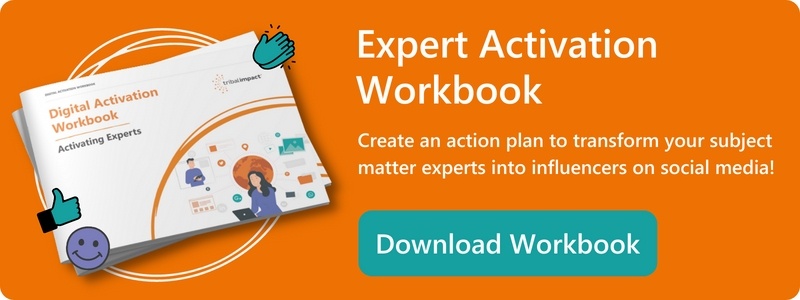Thought leadership is one of the most effective tools an organisation can use to demonstrate its value to customers during a tough economy. Research by Edelman found that thought leadership can effectively influence the purchasing decisions of 49% of decision makers.
In a LinkedIn Live episode, Sarah Goodall chatted with Ashley Faus, director of integrated product marketing from Atlassian.
They discussed how to become a thought leader and raise your influence on LinkedIn. If you’ve got an organisation of subject matter experts and you want to elevate them as ambassadors, this interview is perfect for you.
You can listen to the full interview below, or read the summary of what they discussed in this blog.
What does thought leadership mean on LinkedIn?
A study by Grist found that 46% of decision makers want content that explores issues or challenges from new and different perspectives, and 32% want analyses of important or emerging trends.
Thought leadership is all about putting your own unique perspective and analysis on what’s happening in your industry. Ashley categorises it into four pillars (see next section).
She explained that LinkedIn is just one place where you can share your perspective.
And building a following is just one way to become a thought leader. LinkedIn is a place where you can do that. But it’s not the only place – if your audience aren’t on LinkedIn, you don’t have to be.
The Four Pillars of Thought Leadership
Ashley’s four pillars of thought leadership are:
- Credibility: Do people believe you when you say things? How often are you asked to cite your sources vs cited as the source?
- Profile: How many people know you? What’s the nature of that network? As you move through, you’ll notice you get accepted more when you pitch at conferences, and you’re included in more prestigious outlets for your writing. You’ll get more inbound requests than outbound. That transition is indicative of your growing platform. When you’re smaller and just starting out, you’ll know most of your followers. As your platform grows, people will know you, but you may not know them.
- Being prolific: How much content do you create? How many channels are you on? The most well-known thought leaders create a lot of content, in a lot of types of assets and formats, and they’re on a lot of channels.
- Strong depth of ideas: Do you do things in a way that’s unique to you? How original, innovative, and creative are you? Use your background and experience, to apply the same tactic to a new problem.
How To Encourage the Technical Team To become Thought Leaders
Ashley started by explaining what she doesn’t do: ‘If someone genuinely hates social media, hates being on stage, hates doing podcasts, hates writing long-form content, only wants to be behind the curtain and behind the walled garden of the company, I actually no longer spend my time trying to convince those people to be out in the world. Because the reality is that in order to be a thought leader, you have to genuinely want to lead. And you have to want to lead externally.’Ashley advised focusing on finding the people already sharing – if you see someone who’s a great internal presenter or writer, ask them if they’d be willing to share externally too.
There are a lot of smart, capable people who aren’t fluent in the skillset of sharing externally. They might share but not do it frequently, or not understand how the algorithm works to maximise their content’s reach.
Pairing those employees with a marketer creates a magical combination where the right expertise gets more reach and engagement.
The Difference Between Subject Matter Experts, Thought Leaders, and Influencers
Ashley explains that people sometimes think that because they share a lot on LinkedIn or they have a large following, that automatically makes them a thought leader. That’s not true.
Influencers often have a high profile but shallow depth of ideas. They don’t tend to create new things, but they are great curators. Their content doesn’t usually push boundaries.
Their credibility is ok, as they wouldn’t have a big following if it wasn’t. And they’re ok on being prolific, but they mostly focus on one or two channels and one or two asset types.
Subject matter experts, in contrast, tend to be quite good with their depth of ideas because they have so much background and expertise.
These are usually your very senior practitioners, so they’re constantly evolving. They’re also high on credibility. But they tend to be low on profile and being prolific.
Subject matter experts have a strong internal reputation but haven’t taken that knowledge outside of the company.
Thought leaders are strong in all four areas.
How To Start Creating Thought Leadership Content
Ashley suggested listening to conversations happening in the office or on Slack channels and asking people about what’s happening in their space. If there’s a new trend, ask if someone would be interested in writing about it.Sarah also suggested using social listening and feeding those insights to your experts, too.
And make sure you’re genuinely interested in the space. Ashley said: ‘You have to fall in love with the audience. A lot of marketers think knowing your audience means just understanding them from a buyer or user standpoint.’
Growing Credibility
People want information from credible sources. To provide that, you need to turn your subject matter experts into thought leaders. Them sharing their industry knowledge can turn them—and the brand—into the go-to sources within your industry.If you’d like help activating your experts on social, get in touch today.

